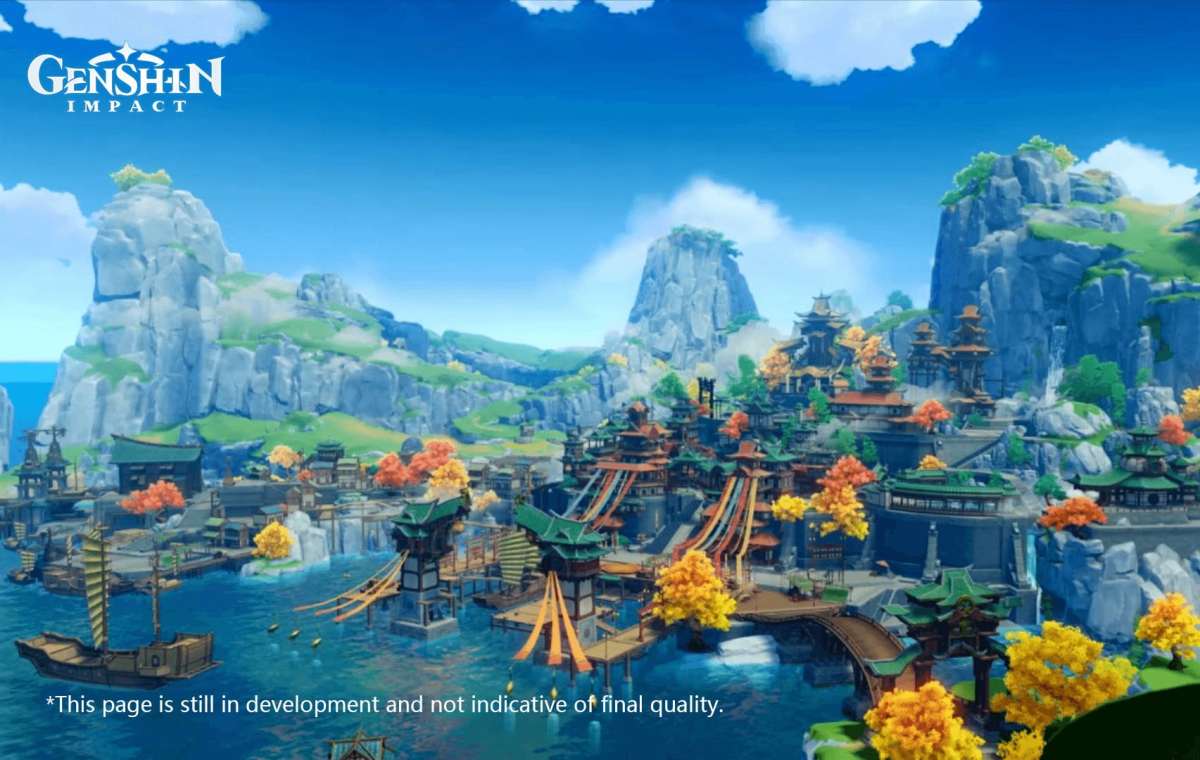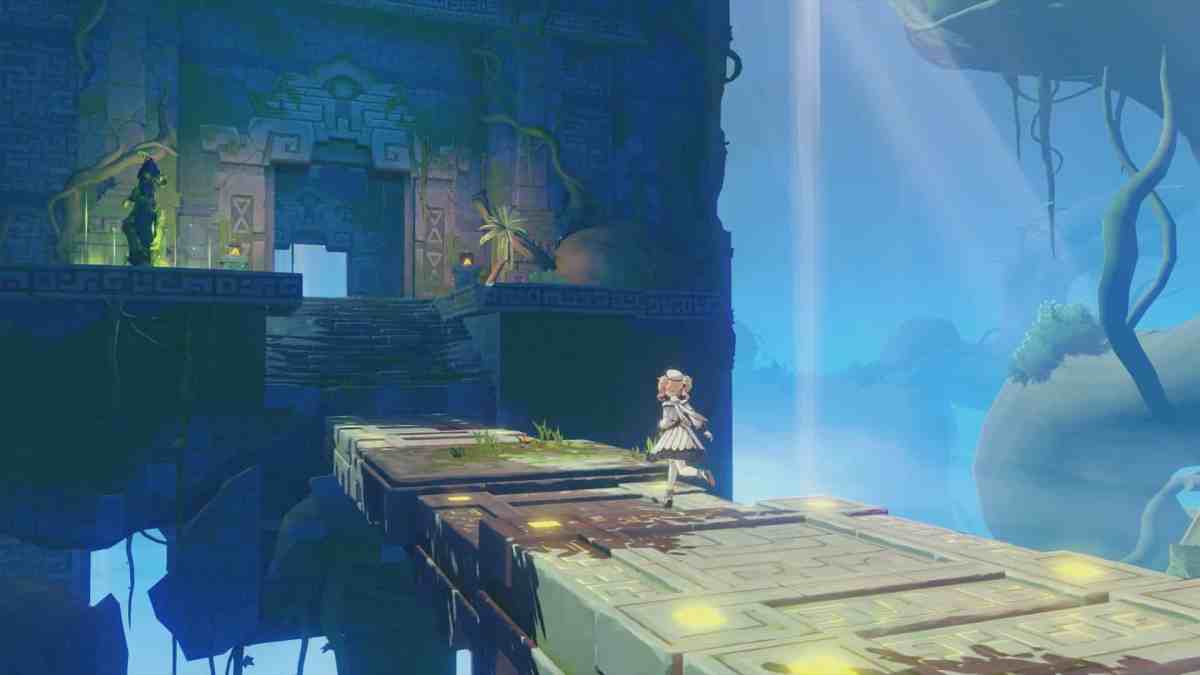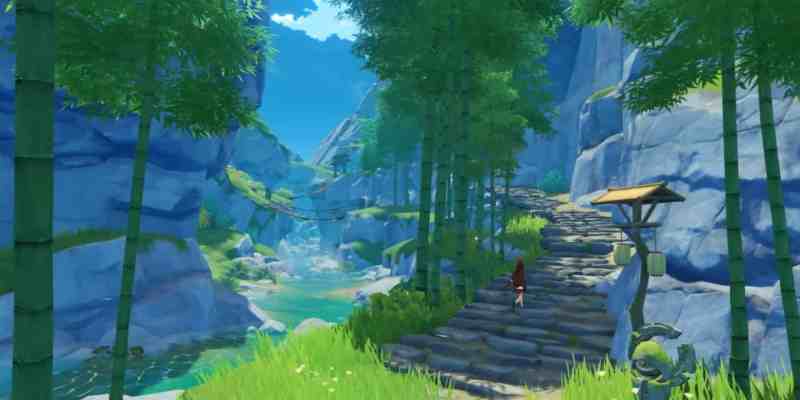At first, it’s hard to shake just how much Genshin Impact has pulled from The Legend of Zelda: Breath of the Wild. Like your stamina ring, which slowly ticks down as you spring, swim, or climb any flat surface placed about the bright and colorful fantasy world that acts as your playground. Or the fact that you’ll be hoovering up ingredients for cooking recipes, spells, and craftable items, many of which you earn from clearing out encampments of enemies that both look and act strikingly like Zelda’s Bokoblins.
And, of course, when you leap off a ledge that’s high enough, you can extend your paraglider and float safely across the sky until your feet touch the ground.
It would almost be enough if Genshin Impact just stopped here. Cribbing the core gameplay elements from 2017’s Breath of the Wild honestly makes sense, given how critically beloved the Switch launch title remains to this day. It’s genuinely surprising to me that more games haven’t pulled wholesale from what Nintendo accomplished when it reinvented Link’s adventure through Hyrule — perhaps that’s something we’ll see more of in the coming generation.
Because as I solved my dozenth environmental puzzle scattered across the map that required the same mixture of curiosity and creativity to uncover as BotW’s Korok Seeds, I couldn’t help but feel comfortable in the gameplay flow carved out by Genshin Impact, despite the rough state that the most recent playable beta was in.
Shanghai-based developer miHoYo isn’t shy about Genshin Impact being inspired by Breath of the Wild — that’s what helped it garner so much initial attention at its reveal last year. That the game wouldn’t just be coming to Switch, but also PlayStation 4, PC, and mobile devices meant a larger possible audience than just Nintendo could reach.
But once I dug a bit deeper in my roughly seven hours with the beta, I was happy to find that it built upon the BotW formula with a variety of different mechanics and ideas that made the whole experience feel like a massive RPG as well. For instance, take how your party is handled. Throughout my time in the game, I amassed a crew of four different playable characters, each one with distinct abilities and move sets that all came in handy in their own way.
My archer Amber could use her unlimited arrows to manage crowds from a distance and ultimately make combat feel a bit like a third-person shooter, and I had a witch named Lisa whose massive electrical spells could cause area-of-effect damage. Only one character is present at any given moment, but you can swap between the four of them on the fly, making battles an exercise in knowing each party member’s strengths and weaknesses.

Each character is also attuned to an element that, much like in the most recent Zelda adventure, reacts with the world in a systemic way. Fire arrows and abilities can burn wooden shields, set grass on fire to create updrafts, and clear vines that act as obstacles. Ice attacks can freeze water and create platforms for you to temporarily walk on. Likewise, electricity spells will deal massive damage to any enemy who might be in said water or are just generally wet.
The interesting thing here is swapping between characters on the fly and using abilities in tandem. Once I got the hang of it, it was incredibly satisfying to torch a group of enemies with fire arrows, then swap to my main character and shoot out a gust of wind that would hit them and create a swirling, flaming tornado. In all, there are seven natural elements that play with one another in neat and interesting ways to really bolster what would otherwise be pretty standard combat and puzzle solving.
There’s also just a lot to do in the world of Genshin Impact. You’ll level up each character, as well as an overall Adventure Rank that opens up new challenges, quests, and instances. There’s cooking, crafting, guilds, and massive towns that feel more like something in an MMO than anything Zelda has ever done.
Notably, Genshin Impact will be a free-to-play game, so there are different forms of currency in the beta. Currently though, it’s not clear what they’ll be used for.

All of these systems combined with the ambitious scale of the world and its mechanics also led to some pretty clunky moments throughout the beta. Frame rate would take a hit in town, it would take a while for characters to pop into the world, and I was just straight up kicked out of the game on two occasions. Plus, the huge amount of items and information at your disposal means menus are a cumbersome mix of radial selections, tabs to flip through, and lists to scroll down.
Again, none of these are fundamental problems and are definitely things that can be fixed in the time between beta and launch. That said, it would be incredibly disappointing if they persisted in the final release.
Despite being rough around the edges, I find myself thinking a lot about the time I spent in Genshin Impact. The bright, colorful world of Teyvat was filled to the brim with interesting places to explore, with great music and a cast of likeable, if not generic, characters you begin to want to hang around. It’s like when a long-running anime hooks you not because it’s considered a classic or is doing something wholly daring or unique, but rather because it’s consistent and familiar.
As much as I love and admire games that push our medium forward and continue to do new things, I can’t help but need comfort food every once in a while, and Genshin Impact could be just that when it comes out later this year on mobile devices, PC, PS4 and Switch.
